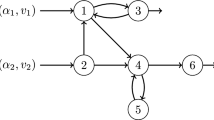Abstract
This paper considers networks operating under α-fair bandwidth sharing. When imposing a peak rate (i.e., an upper bound on the users’ transmission rates, which could be thought of as access rates), the equilibrium point of the fluid limit is explicitly identified, for both the single-node network as well as the linear network. More specifically, a criterion is derived that indicates, for each specific class, whether or not it is essentially transmitting at peak rate. Knowing the equilibrium point of the fluid limit, the steady-state behavior under a diffusion scaling is determined. This allows an explicit characterization of the correlations between the number of flows of the various classes.
Similar content being viewed by others
References
Abendroth, D., van den Berg, H., & Mandjes, M. (2006). A versatile model for TCP bandwidth sharing in networks with heterogeneous users. AEÜ International Journal on Electronics and Communications, 60, 267–278.
Altman, E., Jimenez, T., & Kofman, D. (2004). DPS queues with stationary ergodic service times and the performance of TCP in overload. In Proc. infocom., 2004.
Asmussen, S. (2000). Ruin probabilities. Singapore: World Scientific.
Ben Fredj, S., Bonald, T., Proutière, A., Regnié, G., & Roberts, J. (2001). Statistical bandwidth sharing: a study of congestion at flow level. In Proc. sigcomm., 2001.
Bonald, T., & Massoulié, L. (2001). Impact of fairness on Internet performance. In Proc. sigmetrics/performance, pp. 82–91, 2001.
Bonald, T., & Proutière, A. (2003). Insensitive bandwidth sharing in data networks. Queueing Systems, 44, 69–100.
Bonald, T., & Proutière, A. (2004). On stochastic bounds for monotonic processor sharing networks. Queueing Systems, 47, 81–106.
Dai, J. (1996). A fluid limit model criterion for instability of multiclass queueing networks. Annals of Applied Probability, 6, 751–757.
Fayolle, G., Mitrani, I., & Iasnogorodski, R. (1980). Sharing a processor among many job classes. Journal of the ACM, 27, 519–532.
Gibbens, R., Sargood, S., van Eijl, C., Kelly, F., Azmoodeh, H., Macfadyen, R., & Macfadyen, N. (2000). Fixed-point models for the end-to-end performance analysis of IP networks. In Proc. 13th ITC specialist seminar: IP traffic measurement, modeling and management, 2000.
Horn, R., & Johnson, C. (1985). Matrix analysis. Cambridge: Cambridge University Press.
Hunt, P., & Kurtz, T. (1991). Large loss networks. Stochastic Processes and their Applications, 53, 363–378.
Karatzas, I., & Shreve, S. E. (1991). Brownian motion and stochastic calculus. New York: Springer.
Kelly, F., & Williams, R. (2004). Fluid model for a network operating under a fair bandwidth-sharing policy. Annals of Applied Probability, 14, 1055–1083.
Kelly, F., Maulloo, A., & Tan, D. (1998). Rate control in communication networks: shadow prices, proportional fairness and stability. Journal of the Operational Research Society, 49, 237–252.
Key, P., & Massoulié, L. (2003). Probing strategies for distributed admission control in large and small scale systems. In Proc. infocom., 2003.
Khalil, H. (2001). Nonlinear systems. New York: Prentice Hall.
Kleinrock, L. (1967). Time-shared systems: a theoretical treatment. Journal of the ACM, 14, 242–261.
Kumar, S., & Massoulié, L. (2005). Integrating streaming and file transfer internet traffic: Fluid and diffusion approximations. Available as Microsoft Research Report MSR-TR-2005-160.
Leskelä, L. (2006). Stabilization of an overloaded queueing network using measurement based admission control. Journal of Applied Probability, 43, 231–244.
Lieshout, P., Borst, S., & Mandjes, M. (2006). Heavy-traffic approximations for linear networks operating under alpha-fair bandwidth-sharing policies. In Proc. valuetools, 2006.
Massoulié, L., & Roberts, J. (2002). Bandwidth sharing: objectives and algorithms. IEEE/ACM Transactions on Networking, 10, 320–328.
Mo, J., & Walrand, J. (2000). Fair end-to-end window-based congestion control. IEEE/ACM Transactions on Networking, 8, 556–567.
Meyn, S. P., & Tweedie, R. L. (1993). Markov chains and stochastic stability. London: Springer.
Author information
Authors and Affiliations
Corresponding author
Additional information
Part of this research was done while both authors were with CWI, Amsterdam, the Netherlands.
Rights and permissions
About this article
Cite this article
Ayesta, U., Mandjes, M. Bandwidth-sharing networks under a diffusion scaling. Ann Oper Res 170, 41–58 (2009). https://doi.org/10.1007/s10479-008-0426-y
Published:
Issue Date:
DOI: https://doi.org/10.1007/s10479-008-0426-y




